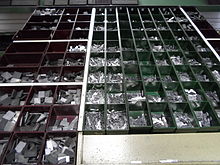Dummy material
As reactive material is defined as the non-printing material to a printing form in the lead sentence . The DIN 16514 of the German Institute for Standardization e. V. describes it as follows: “Non-font high and therefore non-printing parts of the sentence, such as B. Exclusion , squares , piece lead, reglets and ridges ”.
The exclusion in hand typesetting is that part of the dummy material that is inserted between the words or characters on a line. There are different sizes, narrow parts are called spaces and are 1/2 to 1 1/2 points wide. They are also used to lock script. Exclusion, which corresponds to a square area with the height of the font , is referred to as em . Exclusion is both in special compartments of the letter case as well as in special boxes to refill the flasks .
Squares are called blind material with lengths of 2, 3 and 4 cicero and widths between 1 point and 48 point.
Reglettes are used as space between the lines. They will also shoot through called.
Bars are metal parts that fill larger empty spaces. They are used between the columns and also for the edges of the text block.
The standard blank material usually consists of letter metal , an alloy of lead , tin and antimony . Spaces under one point wide are usually made of brass , bars are made of cast iron or an alloy of lead and antimony without tin.
If blank material slides up so far in the printing form that it is also printed, it is called a skewer .
swell
- Severin Corsten, Günther Pflug, u. a. (Ed.): Lexicon of the entire book industry . 2nd Edition. Volume I. Anton Hiersemann, Stuttgart 1987, ISBN 3-7772-8527-7 .
- Paul Fritzsche: The typesetter. A professional customer . VEB Fachbuchverlag Leipzig, 1968.

